E.Orchlon: Transparent, traceable and high quality carbon credits can be an effective bridging mechanisms to get us to net-zero
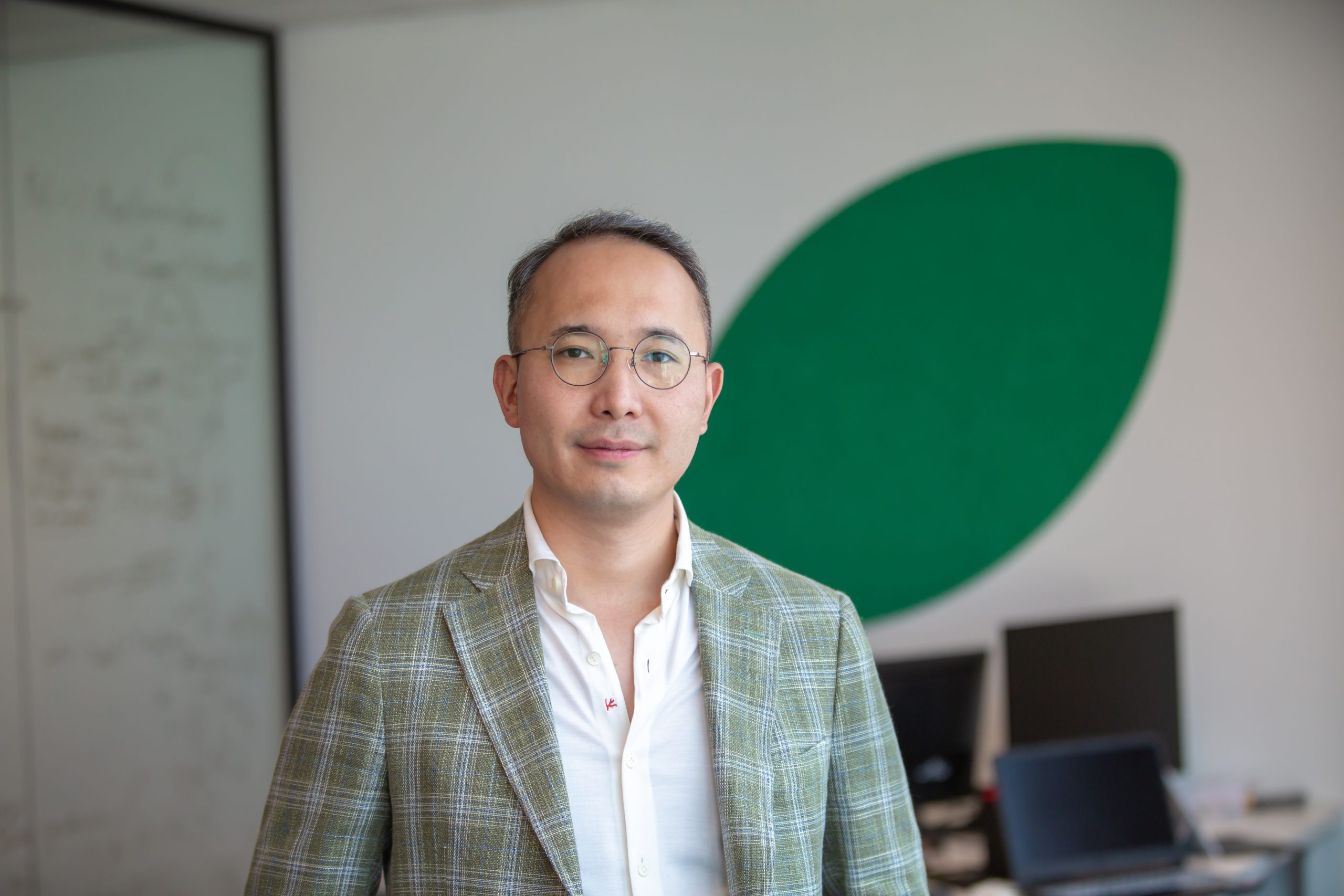
Mongolian Economy spoke with E.Orchlon, the Founder and CEO of URECA Pte. ltd, about the story behind the creation of URECA, the importance of carbon credits in fighting climate change and their vision.
-Could you briefly introduce yourself to our readers?
-Thank you for having me again. I’m the Founder and CEO of URECA Pte. ltd, a climate-tech startup. Previously, I worked as an investment analyst at Newcom Group when the company was raising capital for the Salkhit Wind Farm, the very first wind farm project in Mongolia. Then, I worked in the business analysis team at Oyu Tolgoi LLC for four years. Later in 2016, I made the decision to come back to Newcom Group and served as its Chief Investment Officer and Board Member until November 2021. In parallel, I was appointed as the CEO of Clean Energy Asia LLC in January 2017, a joint venture company between Newcom Group and SB Energy Corp which was building Mongolia’s second wind farm called Tsetsii Wind Farm. I worked at Clean Energy Asia LLC until January 2020. In 2021, I decided to establish a climate-tech startup URECA Pte. ltd with a mission to make the carbon credit markets accessible to all.
-Could you tell us why you decided to establish a climate-tech startup?
-Last year, the smoke from wildfires in Siberia reached Mongolia and filled the sky with smoke for weeks. For me, that was a big wake-up call. It didn’t matter whether you are driving to Khuvsgul or Tuv Aimag, whether you live in Yarmag or Zaisan, or whether you are rich or poor, you couldn’t escape the smoke that covered the whole country. Frequent wildfires are one of the most obvious impacts of climate change. Furthermore, globally, the last eight years have been the hottest years ever recorded. The reports suggest that Northeast Asia might become uninhabitable in a few decades, as temperatures will rise above 50 to 60°C.
I always thought that the best thing I can do for my children is to provide them with financial stability. However, education, job and money will become secondary issues in the future where my children will live, if climate change is not addressed effectively. That’s why we thought we must do our part in fighting climate change. Interestingly, it wasn’t as if I had not been doing anything to address the issue prior to founding URECA. I thought I was doing my best to fight climate change by working in the renewable energy sector building wind and solar farms which helped to avoid carbon emissions in Mongolia. However, as you can imagine building a wind farm takes at least five to six years and also, takes a tremendous amount of energy, financial and human resources. A wind farm obviously has a very positive impact on the environment but I realized their impact can be quite captive in the sense that a single wind farm could provide renewable energy only to 50 to 60 thousand people in a year.
Then, I stumbled upon a climate change model developed by MIT that stated that one of the most effective ways to reduce global carbon emissions is through carbon credits. If carbon credits are used effectively, they can have the largest impact in combating climate change globally. That is something we believe in. It might sound cliche but we want to pass on a planet that is not far worse for our kids.
We all believe that through high-quality carbon credits, we can actually help people and businesses to carry out more environmentally friendly projects and transition to cleaner energy sources.
On top of that, we strive to make it more profitable for people to do that. That’s why we decided to create URECA.
-Why did you choose the name “URECA”?
-It originated from the Greek word “eureka” meaning “I have found it”. The story goes that in the third century B.C. the king of Syracuse didn’t believe his goldsmith whether he made his new crown with pure gold or not. Thus, he charged the Greek scholar Archimedes to find a way to check the purity of the gold of his crown. Eventually, he put the crown in water and measured the water that was displaced to see if it is all gold. When he discovered this principle he exclaimed “eureka”.
The story behind why it is not spelled “eureka” is as follows. A wind farm has to be verified to sell carbon credits, so accreditors had to fly in from Singapore or Hong Kong, visit the wind farm, check it and go to a substation to measure how much renewable power is produced. Then based on that the wind farm will receive verified carbon credits. As it seemed like a lengthy and complicated process, we realized that we could utilize technology to do remote sensing to verify renewable energy generation. That way we could verify and produce renewable energy certificates (“RECs”) remotely without visiting the project site. As we wanted to make RECs accessible to anyone we initially wanted to name our company UREC which stands for universal renewable energy certificate. Then, I think, I was in the shower when I had an “aha moment” and thought we could add an “a” at the end, so it sounds like the Greed word “eureka”. That is how we named our company URECA which is an abbreviation for Universal Renewable Energy Certificate Accreditor.
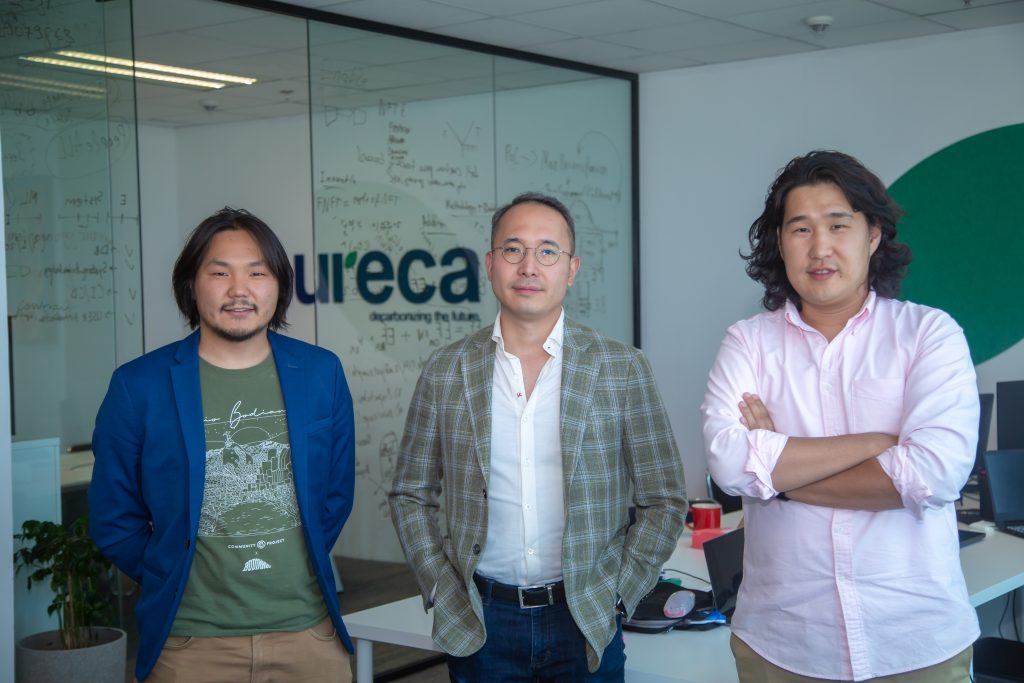
-What makes URECA unique from other carbon credit markets?
-Our main goal is to make carbon credits accessible to all. Today, a lot of people have no idea what a carbon credit is or how it benefits the environment. On the other hand, the carbon credit markets are extremely fragmented. There is a brokerage-based system where most of the demand comes from large organizations that want to voluntarily offset their carbon footprint. You might have seen big corporations like Apple, Microsoft and Google saying that they’re going to be carbon neutral by 2030 or 2050. However, it’s practically very difficult for them to actually make their entire operation carbon-neutral. Therefore, instead, they rely on buying carbon credits to offset their carbon emissions.
When I was running the Tsetsii windfarm, we decided we could also sell the carbon credits from the windfarm to international buyers. However, as we were undergoing the verification process, we realized how fragmented and non-transparent the carbon credit markets truly were. For the above reasons, firstly, through URECA we wanted to enable not only large corporations but also individuals to invest in and buy carbon credits because the price of carbon credits will continue to go up. I personally believe that high quality, transparent and traceable carbon credits could be just as good investments as stocks, bonds and cryptocurrencies. Your money directly goes to projects that are helping to fight climate change. It’s a win-win investment in the sense that a lot of large companies will come looking for carbon credits much more aggressively down the line. Through the URECA platform, we’re stimulating and creating that retail buyer’s market. On the supply side, through our technology, smart meters and AI, SMEs and households can start having their carbon credits verified and generate revenue by selling their carbon credits.
-Who qualifies to generate carbon credits at the URECA platform? How many types of carbon credits are there?
-If you’re undertaking an activity that is reducing, removing, or avoiding carbon dioxide emissions, then you’re eligible to become a carbon credit producer. In terms of removal, there are new technologies that capture carbon dioxide emissions from the atmosphere. Reduction credits come from capturing carbon dioxide by planting trees and plants. Avoidance credits are from activities that reduce emissions by preventing the emission of carbon dioxide into the atmosphere. For instance, renewable energy sources replace coal-powered power plants which means it is helping to avoid carbon emissions.
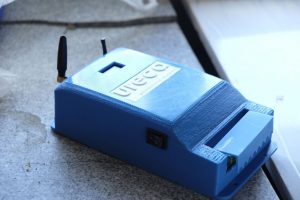
“Tamper-proof smart meter”
Under our pilot project with Asia Foundation, we’re enrolling households in the ger districts that are using renewable energy for the installation of our smart meters. These people who are using solar panels in their gers will be able to sell their carbon credits to companies like Google, Microsoft, or Rio Tinto on our marketplace. At a grassroots level, we’re allowing people to be able to transition to greener energy solutions with lower costs.
-Carbon credit producers can connect to the URECA platform by either installing a smart meter or connecting remotely through API. Who can be connected remotely? How does URECA’s proprietary technology detect abnormalities and interference from other power sources?
-In a nutshell, people who are using old panels have to be connected with smart meters which will sense exactly how much their panel is producing so we could calculate how much carbon emissions they’re offsetting. A lot of people, especially in the developing world, have panels that are not able to transmit information remotely. With regard to remote connection, the recent wind and solar farms have more advanced systems that are able to transmit information remotely through API, so we don’t need to use additional hardware like smart meters.
The AI ensures that information is genuine. We’ve developed an AI system that takes information from the smart meters or APIs and analyzes whether the energy produced is renewable or not. We trained our AI using hundreds of thousands solar panels so it will be able to detect the production signature from solar panels. Only when the information is verified by our AI it will be written in the blockchain.
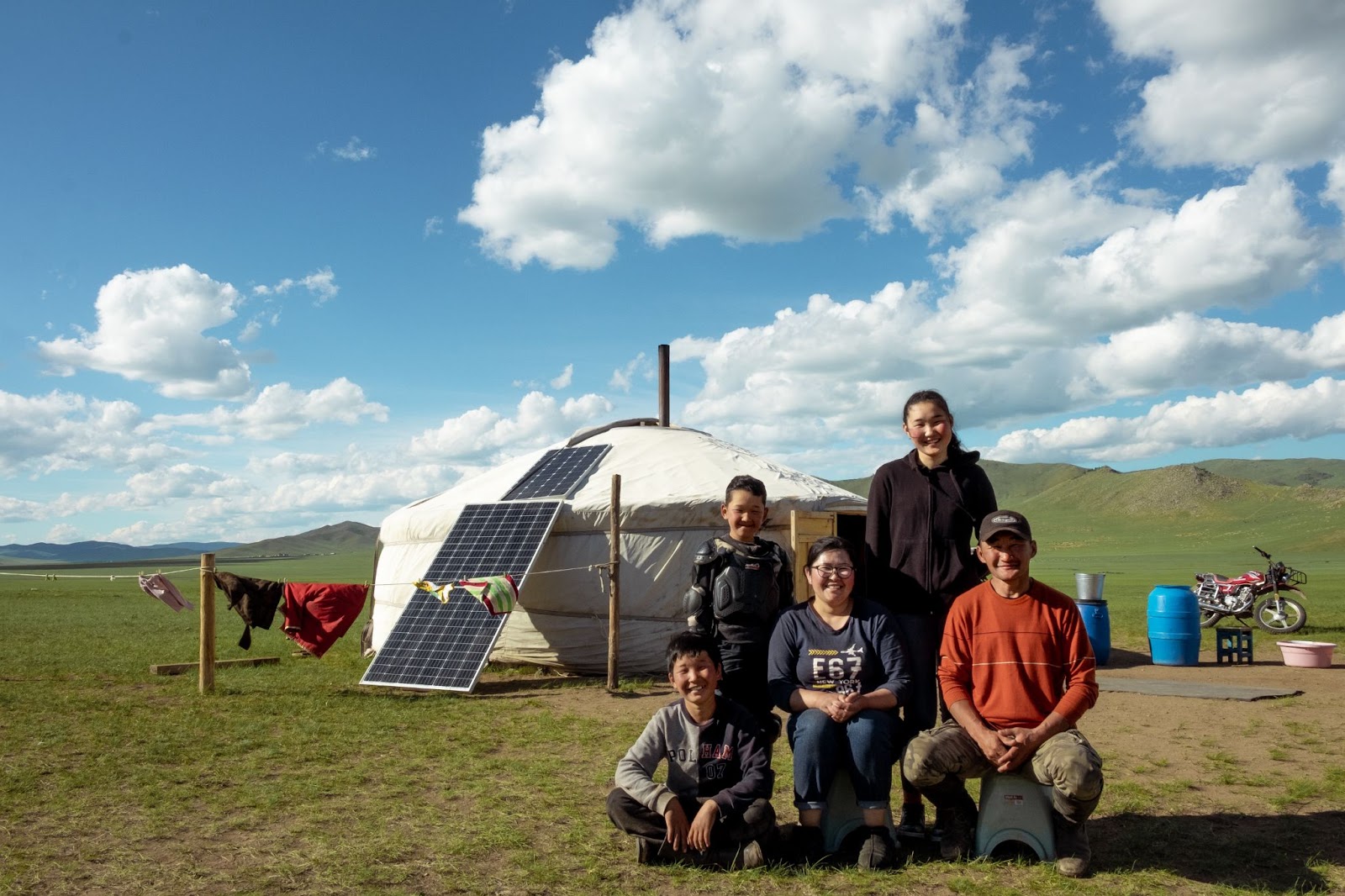
“Participants of URECA’s pilot project with Asia Foundation”
-Let’s say I want to install a solar panel on my roof and sell carbon credits on your platform. Will I get any assistance or financing in purchasing a solar panel?
-It’s an interesting question. Our business isn’t selling solar panels but having said that once you install your solar panel we can send you our smart meters for free. Then, you’ll instantly get your carbon credits verified and start making revenue on the URECA platform which wasn’t possible before.
At this moment, we’re in talks with international and multilateral banks with an aim to put financing facilities for switching to renewable energy sources. That way, you can get loans to buy your solar panels and repay the interest and the loan in a form of carbon credits. That will lessen the financial burden on people transitioning to cleaner energies. It makes it easier and less costly for anyone to switch to renewable energy.
-Which countries are quite interested in purchasing carbon credits from Mongolia?
-It’s an international market. For instance, corporates from countries like Malaysia, Vietnam and Singapore expressed their interest in buying carbon credits from our marketplace. As I mentioned earlier, we want to open up the market for individual investors and traders. Hence, we hope that we will have people investing not just only in carbon credits in Mongolia but also in other countries. For this reason, we’re also listing high-quality third-party carbon credits on our marketplace as well. We hope that we can get people from all corners of the world to invest and trade carbon credits in our marketplace.
-URECA is headquartered in Singapore. Are you planning to expand your operations across Asia in the upcoming years?
-Next year, we’ll be focusing on Southeast Asia and Japan for our market expansion. I think Southeast Asia will be our biggest market. We’ve successfully raised our first round of funding. Furthermore, at the end of this year and early next year, we’ll be targeting more institutional venture capital funds and investors for our second round of funding. I think that will help us to scale and expand our business geographically in the upcoming years.
-Have you worked with enterprises that are concerned with reducing their carbon footprint in Mongolia?
-The marketplace is expected to be launched in November this year. During that launch, we’re going to have a big campaign to raise awareness and we hope that not just international companies but also Mongolian companies will join URECA. One clear example of carbon credits helping the environment can be demonstrated by our partnership with a Mongolian company is exploring to build a large processing facility. The company told us that they were planning to power the new facility using traditional coal-fired power plants but they’re willing to use renewable energy sources if URECA can help them sell their carbon credits. This is what carbon credits are designed to do. We’re glad to witness that our technology is helping not only individuals but also businesses to transition to cleaner energy by making it less costly and more profitable for them to use renewable energy. That’s exactly what we want to do and keep doing going forward.
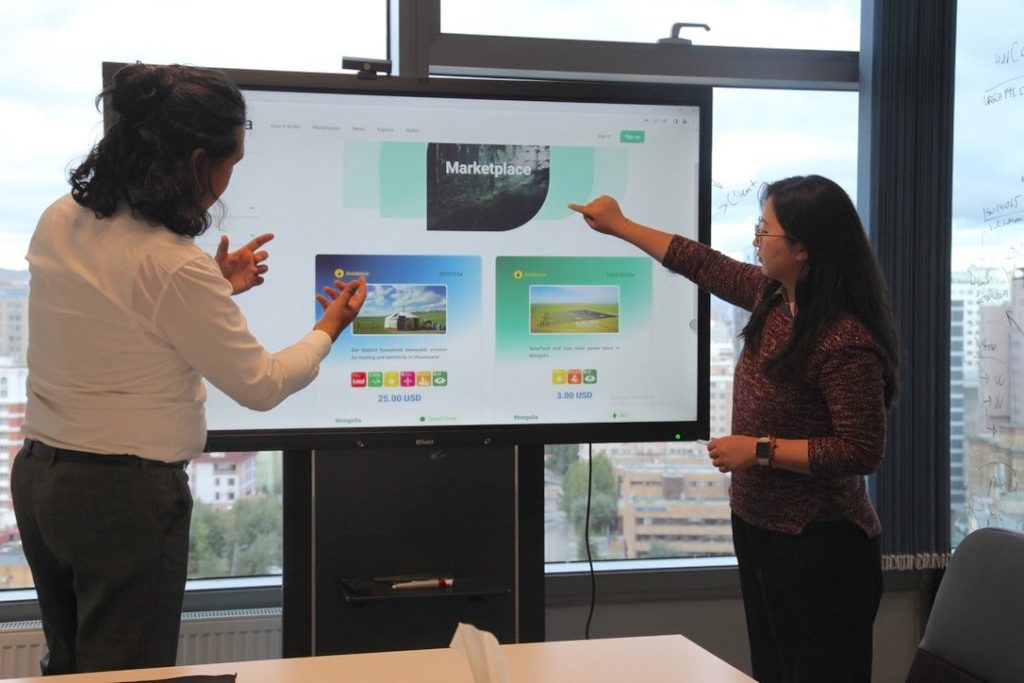
-Most GHG emissions come from China, the US and the EU. If enterprises from those countries want to purchase carbon credits from URECA, will they need a permit or approval from their authorities?
-No, they won’t. There are two types of carbon markets: compulsory and voluntary. URECA is working in the voluntary carbon market space. The majority of multinational corporations are making pledges to become carbon neutral which means it’s a voluntary and not legally binding promise. In other words, corporations go to a “voluntary” carbon market to buy “voluntary” carbon credits to do “voluntary” carbon offsets. International companies are able to buy and use those credits as voluntary offsets and there is no regulation or regulatory hurdles that will stop them from doing so.
-It seems like depending on the location, similar organizations will have different levels of carbon emissions. How accurate can carbon accounting be?
-That’s where the standards come into play. There are several different standards on how you calculate the carbon emissions in each country that are still needed to be updated. Therefore, we’re working on developing our own set of standards and using technology to improve how standards are created and implemented. Depending on each country we need to have a tailored approach to how we calculate carbon emissions.
-According to the Paris Agreement, to limit global warming to no more than 1.5°C, we must reach net zero by 2050. Do you think that not only enterprises but also Governments around the world can and will join the URECA platform?
-I think the Governments will continue to rely on compulsory carbon markets. However, I feel like ordinary people like you and me look up to governments, international organizations and large corporations to help fight climate change. That means we’re witnessing it from the sideline. There are two reasons. First of all, there are no platforms to mobilize ordinary citizens and be effective in fighting climate change. As we’re busy with our everyday lives, we think that there are people, governments, agencies and organizations that are set to do that. Climate change puts the largest existential threat on humanity. We feel that it’s not enough to rely on governments or big corporations. We need to mobilize basically everyone around the world. The best way for people around the world to have an impact is to create a platform like URECA through which they can invest in carbon credits.
Many companies have made these pledges to go carbon neutral by 2030 or 2050. Due to the war in Ukraine, many European countries are going back to turning the coal-fired power plants because of the energy crisis. As a consequence, a quite number of companies won’t be able to meet their aggressive targets by 2030. That means they will start looking for high-quality carbon credits to offset their carbon emissions. If I were an investor, I would invest in carbon credits with a view that two to three years from now, big corporations like Apple are going to knock on my door and buy carbon credits from me. In my view, there is going to be a huge demand for high-quality carbon credits from large corporations that are having trouble meeting their sustainability goals.
-Last but not least, how do you offset your carbon footprints? How about your team?
 -I try to do as much as I can to reduce my carbon footprint. I recently switched to an electric car as it’s environmentally friendly and economically beneficial considering the rising gas prices. Also, I try to avoid business travel and do more remote meetings with my partners in other parts of the world.
-I try to do as much as I can to reduce my carbon footprint. I recently switched to an electric car as it’s environmentally friendly and economically beneficial considering the rising gas prices. Also, I try to avoid business travel and do more remote meetings with my partners in other parts of the world.
Our team is always concerned about their carbon footprint. For instance, we brainstormed what could be the least carbon-intensive means of transportation to get to Terelj for our company retreat. Moreover, we purchased laptops that are 70 percent made of recycled materials. Also, we try not to use our AC and turn off the lights if we’re not using it. We try to take environmental footprint into consideration and our decision-making. That’s the most important thing we could do collectively as a team.
The reason why our employees joined URECA is they believe in what we’re trying to do in helping fight climate change for a brighter future for our children. They’re all passion-driven people so by the virtue of their backgrounds they’re already used to environmentally friendly practices. I think 90 percent of our employees either walk or bike to work.
-Before we conclude our interview, is there anything you would like to say to our readers?
-Our mission is to help and empower people to become part of the solution. We also want to empower people by showing them that they can and have a role to play in combating climate change. For us, the key to fighting climate change is not to build more wind or solar farms but to uplift and empower communities economically and bring equitable economic development across communities. If someone is worried about how they’re going to get food or water tomorrow or next week, the last thing they will care about is how the world might look in 20 years. Ironically, the most vulnerable populations will be affected the most by climate change.
Hence, we think about how could we work with our partners to help and uplift communities in transitioning to cleaner energy in a way it empowers them economically. It’s important for us to get that message across.